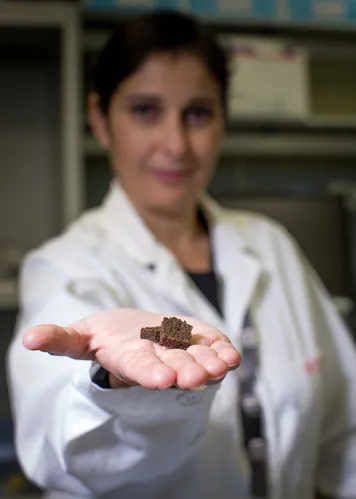How to Clean Water With Old Coffee Grounds
Italian researchers have figured out how to turn spent coffee grounds into a foam that can remove heavy metals from water
/https://tf-cmsv2-smithsonianmag-media.s3.amazonaws.com/filer/ff/b3/ffb3740c-ba7d-4082-8bbe-df00f4c47472/coffee-infused_foam_fcostantini__2016_iit_7038_large__1000_x_1000_.jpg)
In Italy, coffee is practically a religion. Few other countries have made such a high art of turning the roasted beans into drinks both elaborate and deceptively simple—the bracingly bitter ristretto, the feather-light cappuccino, the booze-infused caffè corretto. As a result, at the end of the day, cafes from Milan to Palermo dump tons of spent coffee grounds in the trash along with the stale biscotti and unsold panini.
So it’s fitting that it’s a team of Italy-based researchers that has come up with an innovative way of reusing these spent coffee grounds. The team, at the Istituto Italiano di Tecnologia (IIT) in Genoa, is using coffee grounds to clean water, turning the grounds into a foam that can remove heavy metals like mercury.
“We actually take a waste and give it a second life,” says materials scientist Despina Fragouli, who authored a new study about the coffee discovery in the journal ACS Sustainable Chemistry and Engineering.
Fragouli’s team took spent coffee grounds from IIT’s cafeteria, dried and ground them to make the particles smaller. They then mixed the grounds with some silicon and sugar. Once hardened, they dipped it in water to melt away the sugar, which leaves behind a foam-like material.
This foam, which looks a bit like a chocolate sponge cake, is then placed in heavy metal-contaminated water and left to sit. Over a period of 30 hours, the coffee sponge sucks up almost all of the metals, thanks to special metal-attracting qualities of coffee itself. The sponge can then be washed and reused without losing functionality. The amount of silicon in the sponge is low enough that the entire product is biodegradable.

The coffee sponge could be used in urban waste water processing plants or at industrial sites, according to Fragouli. It’s most effective in non-moving water—in running water, the sponge only removes 60 or 70 percent of the metals. The team is currently conducting research on how to make the product more effective in moving water.
The sponge is the latest in a series of food waste-based biomaterials created by Fragouli and her team.
“We are working on developing new composite materials, and we are especially focused on developing materials that are derived from natural origins,” Fragouli says. “Fruit skins or tomatoes, whatever people want to get rid of, we are elaborating them to make new polymers, or we use powders of the wastes and we mix them with other types of polymers like silicon in order to make new bio composite materials.”
What these materials can do depends on the properties of the waste. Some materials, like the cacao husks (the outer shell of the bean that chocolate comes from), can be used to make packaging. Other wastes can clean oil from water.
Some 1.3 billion tons of food is wasted each year, making it a ripe area for research. And this number doesn’t include things like spent coffee grounds, which are not considered food to begin with.
“[We throw away] 6 to 10 million tons of coffee grounds per year,” Fragouli says. “So it’s really a huge amount of waste.”
Perhaps in the near future, the grounds used to make your cappuccino could clean the water used to make your next one.
/https://tf-cmsv2-smithsonianmag-media.s3.amazonaws.com/accounts/headshot/matchar.png)
/https://tf-cmsv2-smithsonianmag-media.s3.amazonaws.com/accounts/headshot/matchar.png)